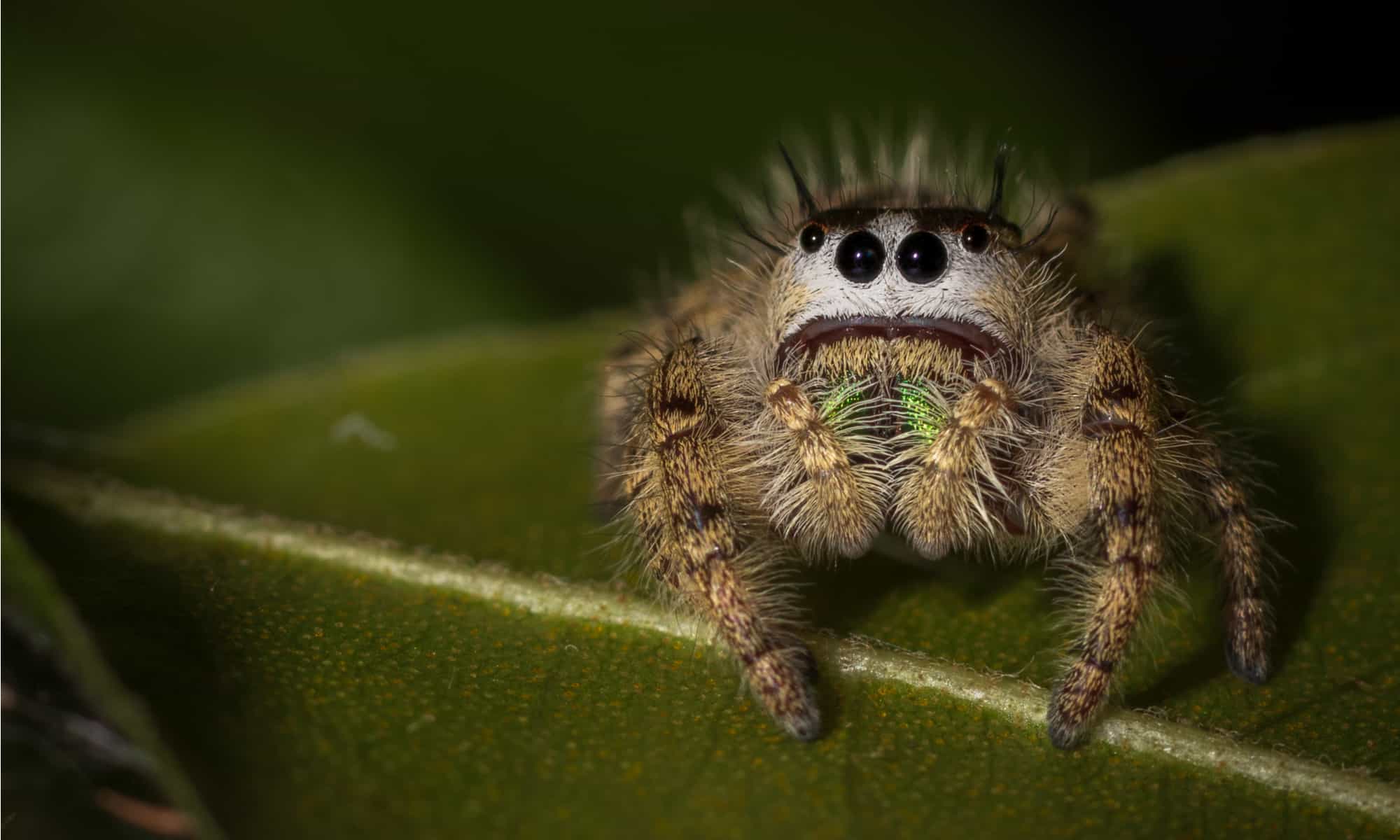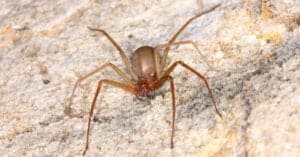While many people may be afraid of spiders, it’s important to remember that they play a crucial role in our ecosystem. Different species of spiders have other attractive traits – for example, did you know that some can spin webs that are strong enough to catch birds? Spiders are essential to the food chain and help keep other insect populations in check. They also eat harmful pests like mosquitoes, which can carry diseases and viruses. So next time you see a spider, take a moment to appreciate all the good they do! Learning about creatures like spiders can help us be less fearful of them, so let’s look at some helpful information about brown spiders commonly found in Kentucky.
1. Southeastern Wandering Spider (Anahita punctulata)
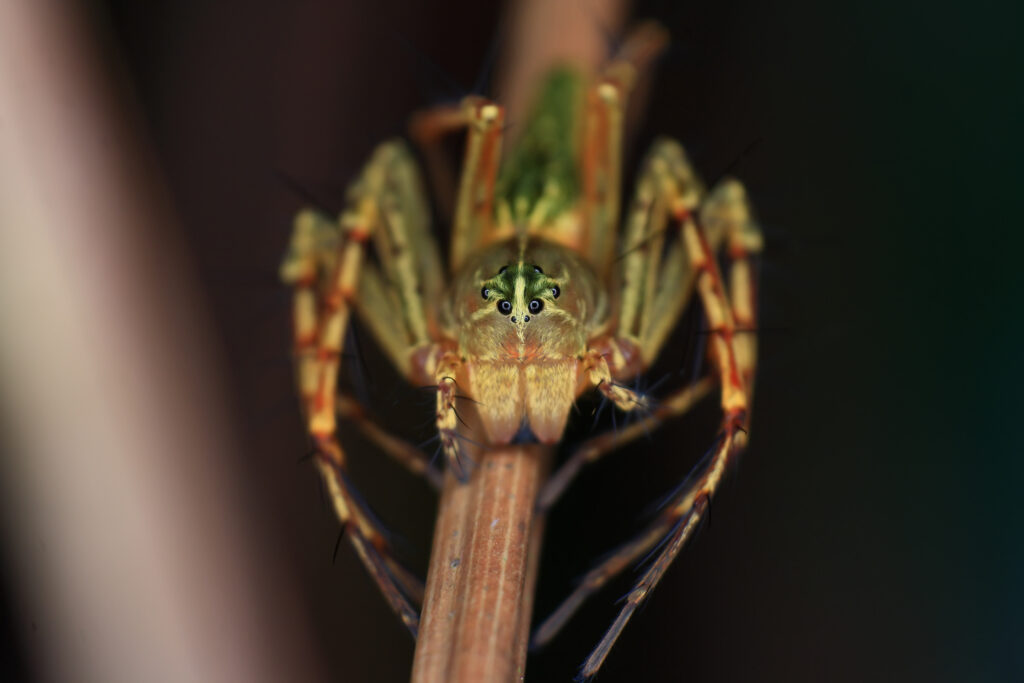
The diet of the southeastern wandering spider typically consists of small insects, such as flies and mosquitoes, as well as other smaller spiders.
©Firdaus Khaled/Shutterstock.com
The southeastern wandering spider is brown or tan in color and approximately 1 inch long. It is a defensive spider known to attack humans and animals if it feels threatened. While this spider is venomous, it is likely only to cause localized swelling and pain in humans when bitten. Despite this spider’s venom not being particularly deadly to humans, it’s still best to take caution and give this spider its space when encountering one in the wild.
The diet of the southeastern wandering spider typically consists of small insects, such as flies and mosquitoes, as well as other smaller spiders. However, this spider has been known to eat small lizards and small rodents occasionally.
Once the male spider has impressed the female and mating has occurred, the female spider will lay her eggs inside a silken sac. She will protect the developing young spiders until they are ready to hatch and venture out on their own.
2. Brown Spiders in Kentucky: Dark Fishing Spider (Dolomedes tenebrosus)
The dark fishing spider is a giant, robust spider that can be up to 1 inch in body length. It is brown in color, with a chevron pattern on its abdomen. This spider commonly lives near water sources, such as ponds, rivers, or streams.
The dark fishing spider is a hunter that preys on small insects and fish, which is why it prefers to live near water sources. It has excellent eyesight and can even see underwater. The dark fishing spider can also swim and dive under the surface when necessary.
The dark fishing spider’s venom is not considered dangerous to humans, but it can be painful if bitten, so always take caution around spiders you aren’t familiar with.
The mating habits of the dark fishing spider are fascinating – the male will wrap the female in silk before mating takes place and will commonly die after mating with the female spider. The female dark fishing spider will then lay an egg sac containing around 1,400 eggs, later hatching as spiderlings.
3. Furrow Orb Weaver (Larinioides cornutus)
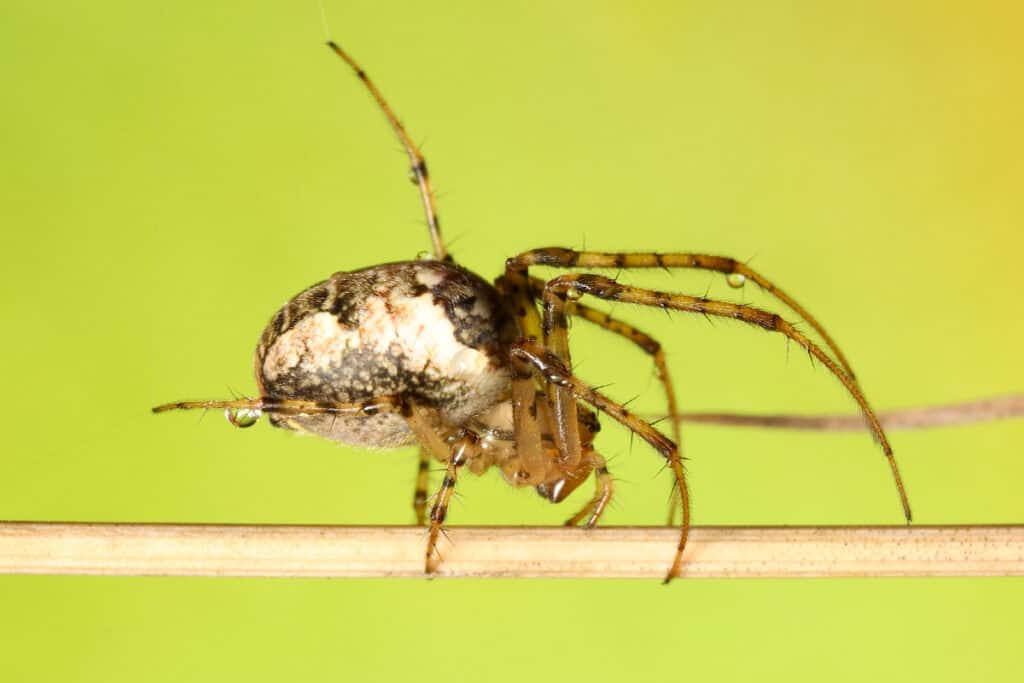
The furrow spider possesses intricate, foliate markings that look like arrows.
©iStock.com/Dan Olsen
The furrow orb weaver spider is usually brown or gray in color and has a distinctively shaped abdomen. The female spiders are typically bigger than the males and can reach up to half an inch in size. The male spiders are usually smaller, only about 1/3 an inch in size.
The furrow orb weaver spider is a nocturnal creature that is most active at night. During the day, this spider hides in its web or under rocks or leaves. This spider builds its web in open areas such as fields or gardens and often spins it close to the ground.
The furrow orb weaver feeds primarily on insects but has also been known to eat small lizards and frogs. When an insect gets caught in the spider’s web, this spider will quickly wrap it up in silk and then bite it to inject venom. This venom paralyzes the prey so the spider can eat it at leisure.
When it comes time to mate, the male furrow orb weaver will approach the female carefully to avoid getting caught in her web. Once he has reached her safely, he will deposit his sperm on her body before quickly scurrying away again to avoid getting eaten. The female will then lay her eggs inside a silken sac which she hangs from her web. She guards this sac until the baby spiders hatch and disperse into the world alone.
4. Brown Recluse Spider (Loxosceles reclusa)
The brown recluse spider is a tiny brown spider that typically measures between 1/4 and 3/8 of an inch in length. It has a dark brown violin-shaped mark on its back, which is where it gets its other common name: the fiddleback spider. This marking is used to help identify the brown recluse spider, as many other types of spiders are similar in appearance.
The brown recluse spider is shy and reclusive by nature (hence its name) and is not aggressive toward humans or animals. However, if it feels threatened, it will bite in self-defense. The venom of the brown recluse spider can be harmful to humans, and bites should be treated immediately by a medical professional if you suspect to have been bitten by one.
The brown recluse spider typically feeds on small insects such as ants and beetles. It will also eat other spiders if given the opportunity.
When mating, the male will try to impress the female before mating. He may perform a mating dance or bring food as a gift. After mating, the female will lay eggs that hatch into baby spiderlings after approximately four weeks.
5. Brown Spiders in Kentucky: American Nursery Web Spider (Pisaurina mira)
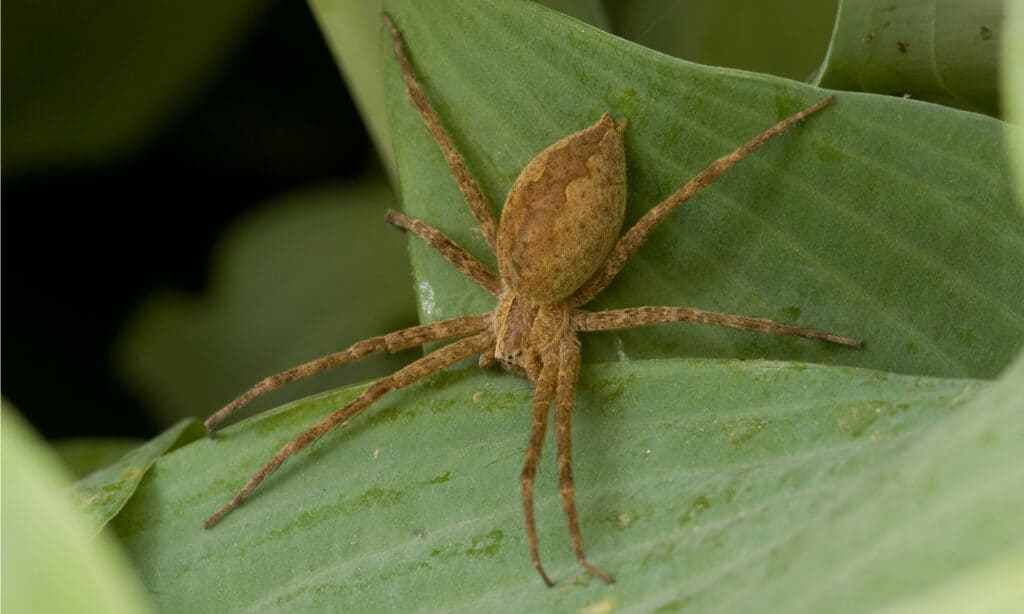
Male American nursery web spiders will tie females’ legs during mating to avoid being eaten afterward.
©SDeming/Shutterstock.com
The American nursery web spider is most commonly found near water sources, such as ponds and streams. They get their name from how they build their webs – large and flat with a funnel-like opening.
The nursery web spider is usually brown or gray and can grow up to 0.6 inches or 15 mm long. Nursery web spiders are not aggressive and will only bite if threatened. But if you are bitten, don’t worry; their venom is not harmful to humans, although it can be painful.
American nursery web spiders typically eat insects, such as flies and mosquitoes.
When mating, the male nursery web spider will build a small web for the female. He will then wrap her up in silk and present her with an insect as a gift. If she accepts his gift, they will mate. The male must quickly escape before being devoured.
After mating, the female will build a large egg sac to lay her eggs. She will stay with her eggs until they hatch, then spin a new web to catch food for her young.
6. Brown Spiders in Kentucky: Tan Jumping Spider (Platycryptus undatus)
The tan jumping spider is tiny, measuring only about 0.31 to half an inch long, with females being on the larger side and males on the smaller. This spider is brown in color with darker brown markings on its abdomen. The tan jumping spider is known for its large eyes and long legs. It is a very agile spider and may jump up to 50 times its body length.
This spider feeds mainly on small insects, such as flies and ants. It uses its venom to kill its prey before eating it.
The venom of the tan jumping spider is not harmful to humans, but if you are allergic to spider venom, you must seek medical attention immediately!
When mating, the male tan jumping spider will perform a special dance to attract the female. They will mate if she is interested, and like many other spiders, the female will lay her eggs inside a silken sac. The young spiders will hatch from their eggs after about two weeks and are immediately independent.
7. False Black Widow Spider (Steatoda grossa)

False
black widow spiders
are not aggressive and will only bite humans if they feel threatened.
©Dan Olsen/Shutterstock.com
The false black widow spider is a member of the Theridiidae family and is closely related to the actual black widow spider. They are often mistaken for one another because they look very similar.
The false black widow spider is usually dark brown to black in color and may sometimes have a red or orange hourglass shape on its abdomen. These spiders range from 0.23 to 0.4 inches or 6 to 10 mm for males and 0.4 to 0.55 inches or 10 to 14 mm for females.
False black widow spiders are not aggressive and will only bite humans if they feel threatened. Their venom is not as potent as that of the black widow spider, but it can still cause some localized pain and swelling at the site of the bite. These spiders are naturally shy and would much rather run away than fight.
When it comes to food, false black widows prefer small insects like flies, mosquitoes, moths, and beetles. They will also eat other tiny spiders. These spiders are nocturnal hunters and build webs during the day to catch their prey at night.
Mating season for false black widows typically occurs in the spring. Females will lay anywhere from 200 eggs per sac, which hatch after about 2 to 4 months.
8. Brown Spiders in Kentucky: Communal Spider (Anelosimus studiosus)
Like many others, the communal spider is an integral part of the ecosystem and plays a vital role in controlling the population of insects. The communal spider is a tiny, brown spider that typically measures 0.2 to 0.3 inches or 5 to 8 mm long. It has a round abdomen and long, thin legs.
This spider is not considered dangerous to humans, as its venom is not strong enough to cause severe harm. However, it can bite if it feels threatened or is accidentally crushed.
The communal spider feeds primarily on small insects such as flies, ants, and moths. It uses its long legs to spin webs that trap these insects. The spiders then wrap their prey in silk and feed on them at their leisure.
Mating season for the communal spider typically occurs during the summer months, although it can also happen outside of this time. During the mating season, males will search for females. After mating, the female will lay her eggs inside a silken sac that she attaches to her web. Once the eggs hatch, the young spiders will disperse and build their own webs nearby.
9. Brown Spiders in Kentucky: Canopy Jumping Spider (Phidippus otiosus)

Canopy
jumping spiders
are curious creatures and often approach humans out of curiosity.
©OBX Wildlife/Shutterstock.com
This tiny spider is unique, with large eyes that help it see prey from far away. Like other jumping spiders, its long legs enable it to jump great distances – up to 50 times its body length.
Canopy jumping spiders are curious creatures and often approach humans out of curiosity. They are not aggressive, however, and will only bite if they feel threatened. Although these spiders do have venom, it is not potent enough to cause humans any harm and may not even be able to pierce the skin in the first place.
These spiders primarily eat insects and small animals, and they use their venom to kill their prey.
When it comes to mating, males often give the female a “gift” of food before attempting to mate. If she accepts his gift, they will mate. He will quickly move on to another potential mate if she rejects it. After mating, the female will lay her eggs inside a silken cocoon. The young spiders will hatch after about one to four weeks and remain in the nest for another month before venturing out on their own.
Thank you for reading! Have some feedback for us? Contact the AZ Animals editorial team.

